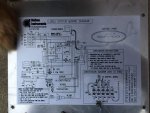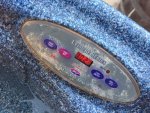Hello,
I bought a used Marquis Oasis Leisure spa which was wired for 240V. I hired a licensed electrician to come out and wire it up for 120V to save on the costs in dealing with installing 240V outside.
It took about 2 days to heat up from ambient (probably 64°F) to 95°F and is stuck there. The temperature drops pretty quickly if I disconnect the spa, and it rises a bit (the highest I've ever gotten it is 98°F) if I baby it by running the jets every 20 minutes or so (on an 8 minute shutoff cycle). I measured the resistance across the heating element and it seemed fine (not open loop and not zero, I don't remember the exact reading 16KOhms, maybe?), but even when the heat light is on, I didn't measure any voltage across the terminals.
The attached diagram indicate swapping J8 from 30A to 20A, but, J8 isn't a jumper terminal. J23, however, is, and that's set appropriately.
There is an off board transformer and an off board relay. I don't know if either of them would need to be replaced, but as the "Conversion Instructions" don't mention it, it would seem odd. The Relay is a Zettler AZ2280-1C-240A. I haven't checked the transformer yet.
I bypassed the pressure switch, and that didn't seem to change anything.
I ran it without the filter, and that didn't seem to change anything.
Any ideas? I'll triple check all the wiring.
Oh, and QUESTION: There is no earth ground connected. I disconnected it at the pickup location, but never replaced it. Is an earth ground necessary in a 120V GFI setup?
Thanks for any tips. I've been screwing around with this for weeks and learned a lot about spas, but haven't solved my problem yet...
David

I bought a used Marquis Oasis Leisure spa which was wired for 240V. I hired a licensed electrician to come out and wire it up for 120V to save on the costs in dealing with installing 240V outside.
It took about 2 days to heat up from ambient (probably 64°F) to 95°F and is stuck there. The temperature drops pretty quickly if I disconnect the spa, and it rises a bit (the highest I've ever gotten it is 98°F) if I baby it by running the jets every 20 minutes or so (on an 8 minute shutoff cycle). I measured the resistance across the heating element and it seemed fine (not open loop and not zero, I don't remember the exact reading 16KOhms, maybe?), but even when the heat light is on, I didn't measure any voltage across the terminals.
The attached diagram indicate swapping J8 from 30A to 20A, but, J8 isn't a jumper terminal. J23, however, is, and that's set appropriately.
There is an off board transformer and an off board relay. I don't know if either of them would need to be replaced, but as the "Conversion Instructions" don't mention it, it would seem odd. The Relay is a Zettler AZ2280-1C-240A. I haven't checked the transformer yet.
I bypassed the pressure switch, and that didn't seem to change anything.
I ran it without the filter, and that didn't seem to change anything.
Any ideas? I'll triple check all the wiring.
Oh, and QUESTION: There is no earth ground connected. I disconnected it at the pickup location, but never replaced it. Is an earth ground necessary in a 120V GFI setup?
Thanks for any tips. I've been screwing around with this for weeks and learned a lot about spas, but haven't solved my problem yet...
David



